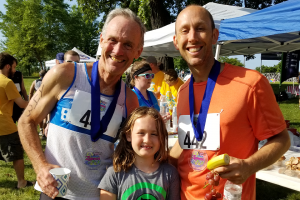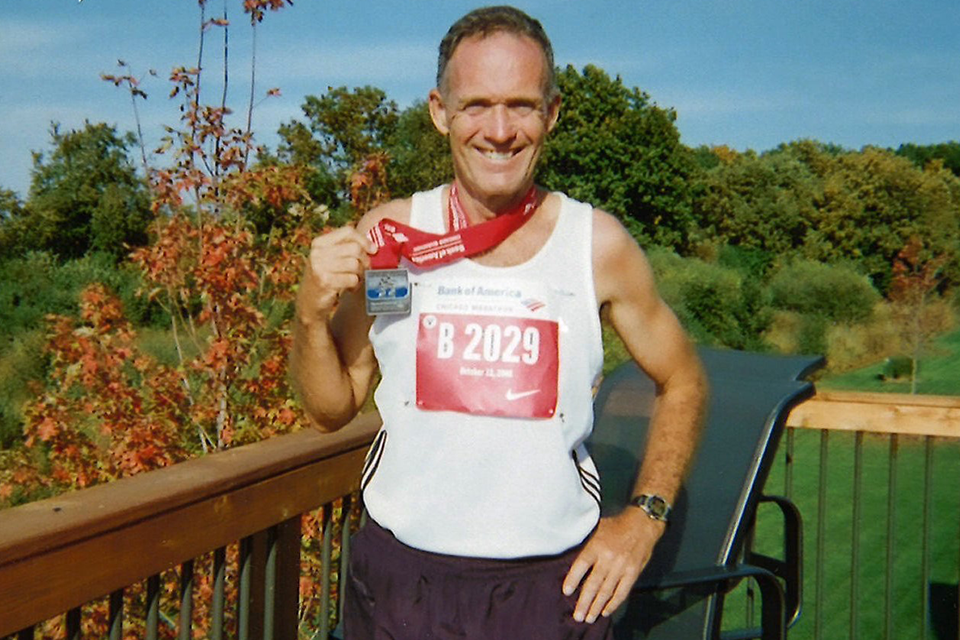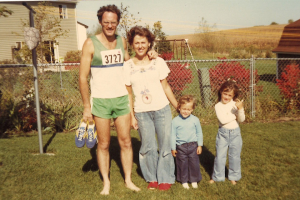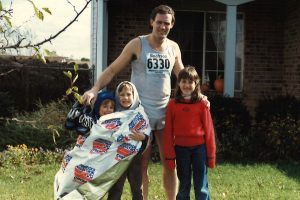The marathon race was inspired by a Greek messenger, Phidippides, who ran 25 miles from Marathon to Athens to deliver the news of an important Greek victory. Exhausted, the Greek messenger collapsed and died.
So why is a modern-day marathon race 26.2 miles? When the Olympics were held in London in 1908, the day before the race, the queen requested that the start line be moved so she could see the runners start from Windsor Castle. That extended the distance 1.2 miles.
Needless to say, running a long distance is a huge feat for anyone. For the 71-year-old Randy Burt ’73, M.S.’74, the feat is running every Chicago Marathon to date with this year marking his 42nd.
Burt grew up on the south side of Chicago and ran cross country at Bremen High School in the 1960s. When he went to Illinois State to pursue a degree in physical education, running was put on the back burner.
“I was drafted for the Vietnam War in the middle of my undergrad,” he said. “When I returned to finish my bachelor’s degree, ISU was one of five universities to offer occupational safety, so I decided to pursue my master’s as well.”
Burt’s master’s degree in occupational safety landed him a job in California in the 1970s for Pacific and Gas Electric. It was there that he reignited his love for running. “I ran the famous Bay to Breakers Race in San Francisco, and I realized how amazing it was to run again,” Burt reminisced.
Burt decided to move back to the Chicagoland area after his first child was born. Not only did this bring him closer to family, but he found more opportunities to run. “There were lots of running communities that came together in 1977,” he said. “They came together to create the first Chicago Marathon that year.”
Wanting to run at least one marathon before he was “over the hill,” Burt set his sights to run not only his first marathon ever, but the first Chicago Marathon set to take place in 1981. Little did he know that he would fall in love with everything about this race.
Running his first marathon in 3:32, Burt recalls not being prepared in the slightest. “I ate a lot of pizza the night before and wore all cotton,” Burt reminisced. In contrast, his fastest marathon was the 1984 Chicago Marathon, with a time of 3:05.
Eighty-three marathons later, Burt is more than prepared whenever he steps up to the start line, but that doesn’t come without months of training prior to the big race.
To train, Burt focuses on speed work, tempo runs, and long runs. Due to a body that is growing stubborn, he focuses more on tempo and long runs, running 20 miles six times prior to marathon day, and skipping speed work altogether.
Since his first marathon in 1977, Burt has committed to running two every year, one in the spring and one in the fall. His fall marathon, if one could guess, is always the Chicago Marathon. His spring marathon has been in Kenosha, Wisconsin, but Burt has also qualified to run the Boston Marathon in April.
“I have two goals for all of my marathons,” Burt explained. “The first is to finish the marathon, which I have done every time. The second is a time goal based on training and other factors. My goal used to be to qualify for the Boston Marathon with my time each year. This year’s goal is to finish in 04:39.”
2019 was the first time in 31 years that Burt didn’t qualify for the Boston Marathon. Although he has qualified for the historic race 46 times total, he only ran it in 1989, 1996, and 2005.
To Burt, there is no race like the Chicago Marathon.
Listed as one of the Abbott World Marathon Majors, which is a series of six of the largest and most renowned marathons in the world, people come from all over to run in the Windy City every October. Since 1977, the number of runners has increased from 4,200 to over 42,000.
“It is one of the fastest courses in the world,” Burt said. “There are nearly two million spectators for one day in just a few hours. The end of October proves the best marathon conditions. It’s nice and flat and goes through all the Chicago neighborhoods. World records have been set at the Chicago Marathon course and people come here to qualify for Boston.”
“The last 10k [6.2 miles] gets to be tough,” Burt adds. “It’s like the night of the living dead for the last few miles. The support from the millions of spectators helps a lot.”
The atmosphere alone has made Burt fall more in love with the Chicago Marathon each year, but there are more reasons for him to keep coming back. Although there are hundreds of marathons to run, including the six Abbott World Marathons that Burt has thought about running, his history with the Chicago Marathon forges deeper than any race ever could.
“They call us the alumni runners,” he said. “There are four of us who have run every single Chicago Marathon and it’s a little hard to believe, but it’s fun to be a part of this special small group of runners.”
The oldest alumni group member is 79 years old, but the small pack has been retiring about one person a year for the past four years.
“I can’t believe I was 29 when this whole thing started,” he said. “After my second marathon, slower than my first, I said I would never do one of these again. I was throwing up in a trash can. Then a few days later, I thought about it, and I wanted to do another one. I just couldn’t help it.”
Despite Burt’s doubts of ever running another marathon after 29, he has done the complete opposite, and he would not be in this position without the support of his friends and family.
“They always want to know how I did, and they congratulate me and chat about the ups and downs.”

Burt with his son and granddaughter after the Lake Zurich Triathlon in July 2019 where he came in first in his age group for the fourth year in a row.
Forty-two years later, Burt’s life-long running goal is to cross the finish line of the 50th Chicago Marathon in 2027. This would not only be his 50th Chicago Marathon finish but his 100th marathon finish at the age of 79.
As for this year, Burt is looking forward to enjoying the Chicago scenery and the supporters. Because he is one of four alumni runners left, he will be close to the start line in the first wave of runners by the Art Institute of Chicago.
“First of all, marathons are the most incredible running event in the world,” Burt explains to aspiring marathon runners. “Anyone can do it if they set a realistic goal and train properly for it. Do research and find out what’s ideal for your fitness level and stick with that plan.”
As far as marathon races to run go, Burt only has one suggestion. “If you want a good marathon… come to Chicago.”



